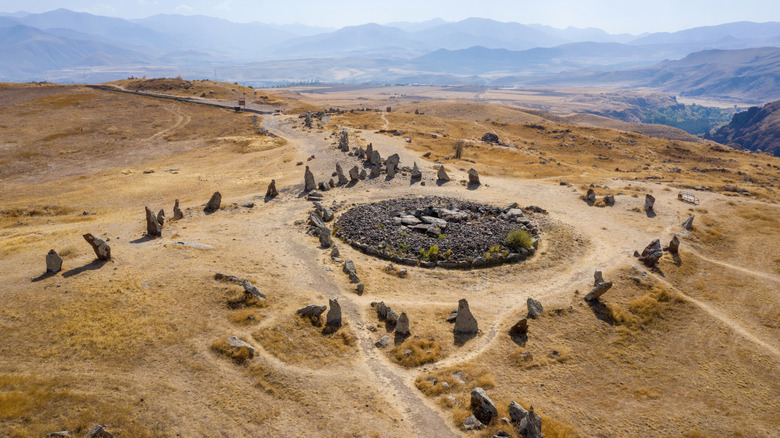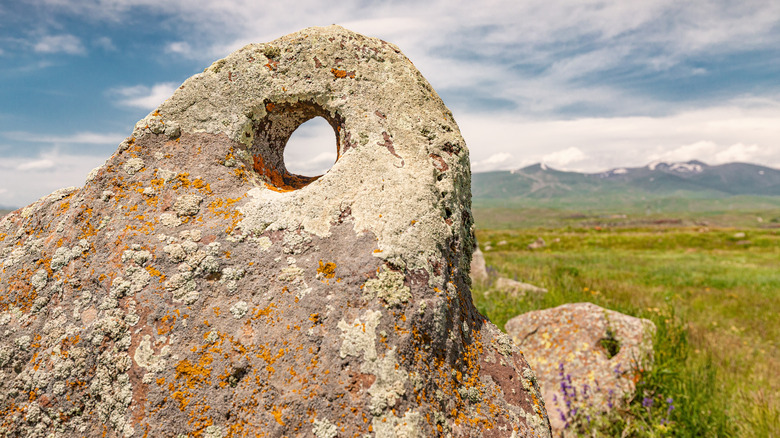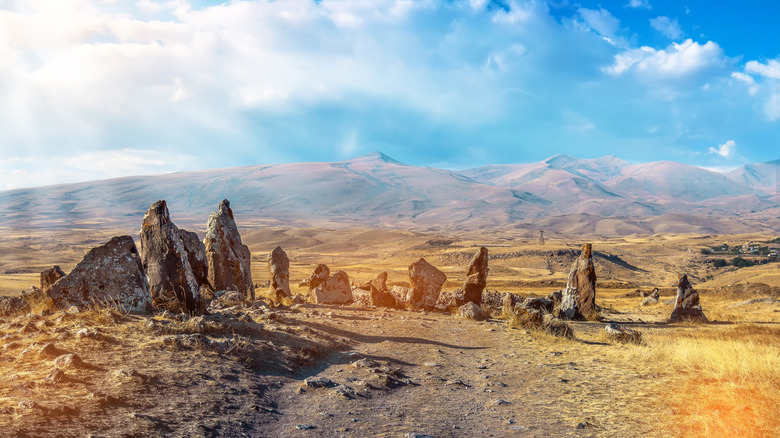The Ancient Site Often Called The 'Armenian Stonehenge' Predates Its English Counterpart
Many destinations like to compare themselves to iconic landmarks. North Cascades National Park, one of the snowiest places in the world, is often referred to as the "American Alps," while a mysterious site in New Hampshire that's more than 4,000 years old is known as "America's Stonehenge." But what if there was a version of Stonehenge that not only rivals its English counterpart, but actually predates it? That monument exists in Armenia, and it's called Carahunge.
Carahunge is known by many names — locals refer to it as Zorats Karer, which translates into "stones of power". You'll also hear some people calling it Dik-Dik Karer, meaning "standing rocks". The reason why this attraction is dubbed the "Armenian Stonehenge" is due to its striking similarities to the famous British location. Both are megalithic structures featuring a circle of massive stones, some with holes carved into them. But while the original Stonehenge is estimated to have been built around 5,000 years ago, Carahunge is believed to be even older — around 7,500 years old.
How to get to Carahunge
The best way to get to Carahunge is by driving — it's about three and a half hours from Yerevan, the capital city of Armenia. You can also take a bus from the Yerevan Central Railway Station or Northern Bus Station that'll drop you off in Goris, but it'll take you more than four hours. From there, you can catch a cab straight to Zorats Karer. If you're looking for an extra scenic route, fly from Yerevan to Kapan in a 19-passenger plane, where you'll get to experience an unseen side of the country, full of stunning mountain views. The flight takes about 30 minutes, and from Kapan, it's a two-hour drive. All that time on the road will pay off. Just make sure to steer clear of mistakes on your road trip, like focusing more on your GPS, because the journey is as gorgeous as the destination.
Zorats Karer features 223 boulders ranging from knee-high structures to towering giants over 3 meters tall — some of these are as heavy as 10 tons. You'll notice that many of these stones have holes in them. While their true purpose remains a mystery, there are some possible explanations.
A cosmic journey through myths and history
One common theory suggests that the stones at Carahunge were designed for celestial observations. The alignment and unique features of Zorats Karer point to its function as an ancient astronomical complex used to track the movements of the sun, moon, and stars. Academician Paris Herouni's incredible studies helped Armenians find some answers to their questions. Take, for instance, the stone marked as No. 63, which possibly doubled as a sundial or solar calendar. Despite the enigma of the rocks, several structures further allude to its use. Some of the stones align with the constellation Cygnus, while the central temple is believed to have been dedicated to the god of sun, Ar, in local mythology.
As much as history buffs will love wandering around and learning about its possible origins, Zorats Karer offers much more than a glimpse into the past. As an excellent stargazing spot, Carahunge is far away from the city lights, allowing visitors to view the stellar night sky in all its glory. While there's no on-site museum, the nearby town of Sisian is home to a history museum that houses a section dedicated to Carahunge. You'll see exhibits and findings from its excavation and learn more about what makes this a one-of-a-kind landmark.
As beautiful and crowd-free as neighboring country Georgia's mountainous landscapes are, Armenia hides a treasure trove of old-world secrets — Carahunge being a prime example.


